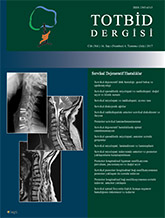
There are many reasons for adjacent segment disease in the disc adjacent to the cervical spinal fusion. Adjacent segment pathology is the definition used to summarize the radiological changes and the clinical signs and symptoms secondary to this degeneration. It is suggested that degeneration is caused by the complex interactions of changing mechanical and biological properties. Clinical findings may not always be consistent with radiological changes in the adjacent segment. It is possible to prevent adjacent segment pathology by selecting appropriate patients, making the correct planning of the surgery, and showing absolute agreement with the surgical technique. The precautions should be taken during surgery to provide postoperative cervical lordosis, to avoid excessive traction in neighboring soft tissues, and to keep at least 3 mm clear from the neighboring disk during anterior instrumentation. The best results for revision surgeons are in patients who have radiologically adjacent segment degeneration, with clinical symptoms of myelopathy and radiculopathy before surgery. Surgical treatment of single level adjacent segment degeneration has options of re-fusion or disc arthroplasty. Multilevel degenerations can be treated by laminectomy, fusion, or laminoplasty if the neutral or lordotic sagittal alignment is preserved. Complication rates are similar to those seen with neighboring segment disease or primary fusion surgery; however, preoperative planning is very important in terms of vocal cord paralysis. Further studies are necessary to determine the role of arthroplasty for primary or revision patients, to prevent adjacent segment degeneration.